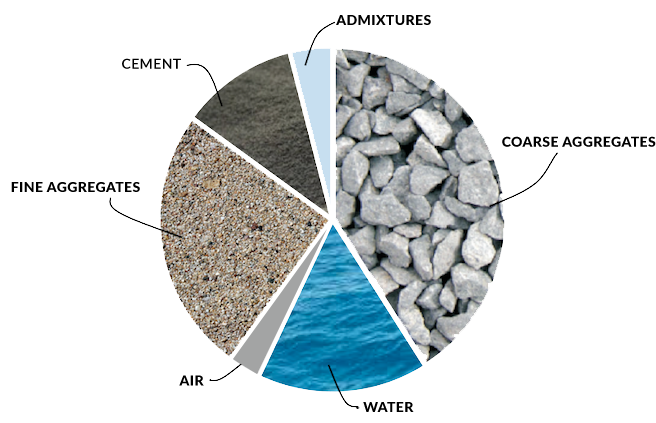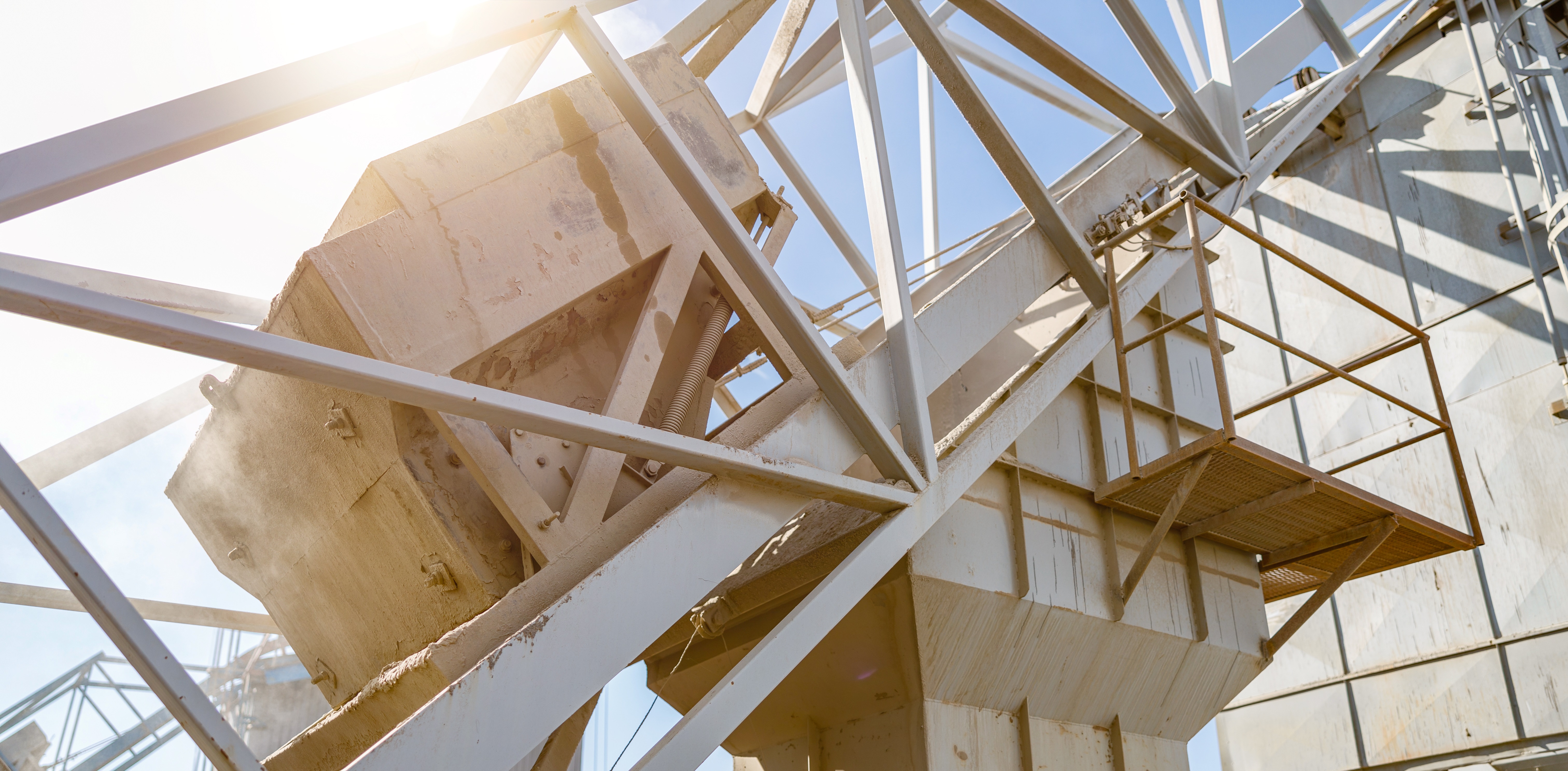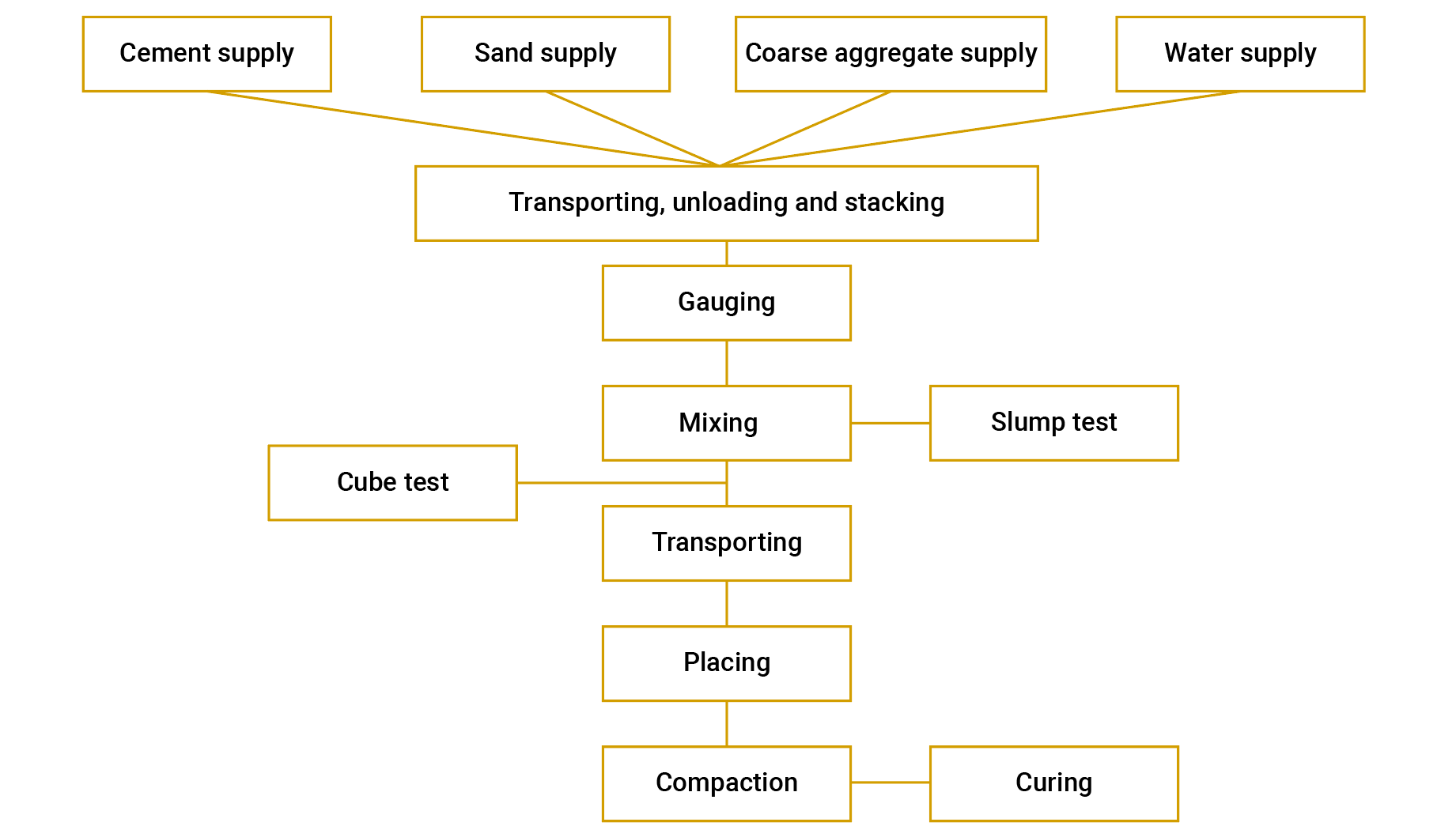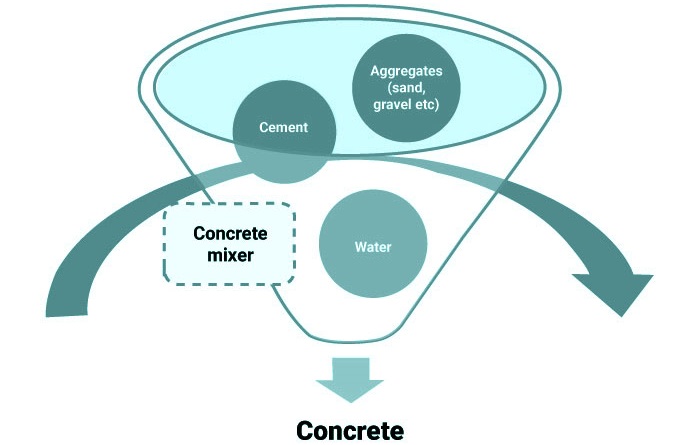| Grade of concrete | Group | Mix ratio (cement: sand: aggregates) |
Specified characteristic compressive strength of 150 mm cube at 28 days (N/mm 2 ) |
|---|---|---|---|
| M10 | Ordinary concrete | 1: 3: 6 | 10 |
| M15 | Ordinary concrete | 1: 2: 4 | 15 |
| M20 | Ordinary concrete | 1: 1.5: 3 | 20 |
| M25 | Standard concrete | 1: 1: 2 | 25 |
| M30 | Standard concrete | 1: 0.75: 1.5 | 30 |
| M35 | Standard concrete | 1: 0.5: 1 | 35 |
| M40 | Standard concrete | 1: 0.25: 0.5 | 40 |
| M45 | Standard concrete | Design mix | 45 |
| M50 | Standard concrete | Design mix | 50 |
| M55 | Standard concrete | Design mix | 55 |
| M60 | High strength concrete | Design mix | 60 |
| M65 | High strength concrete | Design mix | 65 |
| M70 | High strength concrete | Design mix | 70 |
| M75 | High strength concrete | Design mix | 75 |
| M80 | High strength concrete | Design mix | 80 |

Concrete is a homogenous mixture of three basic components, namely – Portland cement; water; and aggregate materials such as gravel, rock, sand etc. While cement and water alone can be mixed to form concrete, the aggregates are added to provide suitable strength and to make the mixture cost effective.
Water chemically reacts with the cement through hydration while forming concrete. Cement and water paste formed by hydration acts as binding material by filling the gaps between the aggregates and keeping the structure together. The ratio of the amount of water to the amount of cement in the mix is called the water/cement (w/c) ratio. The lower the w/c ratio, the stronger the concrete is. In addition to these three basic materials, admixtures are also added to the concrete to achieve certain goals such as quicker or delayed setting, reducing water consumption etc.

The process of measuring the materials for preparing different grades of concrete is called batching. Batching can either be volume batching, where materials are mixed as per their required volumes, or weight batching where materials are mixed as per their self weight ratio. As per IS 456:2000, weight batching is the preferred method and volume batching is to be allowed only where weight batching is not possible and bulk densities of the input materials have already been established previously.
The grade of cement is ascertained to calculate the amount of cement, sand and aggregate materials required for volume batching or weight batching. 3 The grade of concrete is determined by its constituent materials and the minimum strength it would have achieved after 28 days of initial construction. As per IS 456:2000 (fourth revision), concrete can be classified as ordinary concrete, standard concrete and high strength concrete. Table 1 illustrates various grades of concrete and associated determinants in terms of (a) ratio of cement, sand and aggregates in them, and (b) Compressive Strength on a 28 day basis.
The grades of concrete defined in the table of grade wise mix, are the standards grades of concrete. For allotting a designation to concrete, “M” refers to the mix and the number is the compressive strength of 150 mm size cube at 28 days, expressed in N/mm2. For example, standard concrete M50 would have a compressive strength of 50 N/mm2 at the end of 28 days. For concrete of compressive strength greater than M55, the design parameters are difficult to standardise and can be obtained from specialised literature and experimental results. As per the guidelines specified under the standard IS456:2000, the measuring equipment shall have an accuracy of ±2% for cement and ±3% for aggregates, admixtures and other materials being used.
For making higher grades of concrete, the engineer varies the proportion of the input materials as per the design mix of the structure. The concrete grades can go as high as M80 which provides a 28 days strength of 80 N/mm2 which is quite high. The strength provided by this grade of concrete can be ascertained from the fact that generally for making sensitive infrastructure such as bridges, compressive strengths in the range of 34 to 41 N/mm2are recommended. Concrete up to grade M25 is generally used for small scale construction. For larger structures generally grade M30 and above are used.
For the making of concrete, the volume of input, materials required is generally measured as dry volume. As a thumb rule for calculating the dry volume, the wet volume is multiplied by 1.54. To make 1 cubic metre of wet volume of concrete, the quantity of the input materials will vary as per the grade of concrete being manufactured. For instance, to manufacture 1 cubic metre wet volume of M15 grade of concrete, we would need 0.22 cubic metres (316.8 kg) of cement, 0.44 cubic metres (660 kg) of sand and 0.88 cubic metres (1,320 kg) of sand.
For making the concrete, the first step is measuring the materials for mixing, called batching. The aggregates, cement and water should be mixed with an accuracy of ~3 per cent of batch quantity and the admixtures should be mixed with an accuracy of ~5 per cent of the batch quantity to get the desired results. Batching can be done either by volume or by weight.
Next water is introduced into the proportioned materials and ~25% of the required water is first introduced into the mixer drum to prevent any sticking to the blades and bottom of the mixer drum. The mixed concrete is then transported to the place of deposition at the earliest without the loss of homogeneity and taking note that no segregation of the mixture should take place during transport. It can be moved using the following:

 Mortar Pan
Mortar Pan
 Chutes
Chutes
 Skip and Hoist
Skip and Hoist
 Bucket and Ropeway
Bucket and Ropeway
 Wheel Barrow
Wheel Barrow
 Dumper
Dumper
 Belt conveyor
Belt conveyor
 Pumping
Pumping
Cement is mixed with the other ingredients, namely, aggregates such as sand, gravel, crushed stone etc, water, and admixtures if any for making concrete.
It is a multistep process broadly consisting of

The concrete after transportation should be placed with utmost care securing the homogeneity achieved during mixing to achieve the desired strength. Before laying concrete material, foundations for walls and columns should be provided below the ground surface and all the loose earth, dirt etc. should be removed.

Admixtures are natural or manufactured chemicals, which are added to the concrete before or during mixing to provide special properties such as quick or delayed setting, enhanced strength, cold or hot weather placements etc. There are five broad types of admixtures with other special admixtures also finding occasional applications.
Read more
These are added during batching to produce microscopic air bubbles which enhances the concrete's resistance to damage caused by freezing and thawing. Eg. vinsol resin, darex, Teepol etc.
They reduce the water requirement of the concrete to form slump while maintaining the same or similar strength. Eg. Calcium, sodium and ammonium lignosulphonates etc.
These chemicals delay the initial setting time of concrete by an hour or more and are used in hot weather to counter rapid setting, allowing more time for placing and finishing of concrete. Eg. calcium sulphate, starch, cellulose products etc.
They speed up the initial setting time of concrete and give higher early strength. They are used in cooler regions or where fast track construction needs to be carried out. Eg. triethenolamine, calcium formate, silica fume etc.
They are a special class of water reducers, reducing water requirement by 12 to 25% and thus produce well flowing concrete without using much water. Eg. acrylic polymer based, poly carboxylate, multicarbovylatethers etc.
In addition to the five most common types of admixtures, others such as corrosion inhibitors, shrinkage reducers, anti washout admixtures, hydration stablisers etc. are also sometimes used
Less more
| Do’s | Don’t’s |
|---|---|
| Ensure water-cement ratio between 0.4 and 0.6 as per IS10262:2009 | Don’t subject it to excessive weight |
| Estimate the amount of raw materials required for preparing the concrete and add 10% extra as a contingency measure | Don't place concrete on a sub-grade surface that has not been thoroughly compacted and dampened |
| Do necessary testing, such as slump test etc before laying the concrete. Ensure concrete measures well to all testing standards as prescribed under IS456:2000 and IS10262:2009 | Don't place concrete over an area that has freestanding water, or muddy, frozen or soft spots |
| Mix concrete thoroughly to ensure that no water puddles or dry bits are left in the mixture | Don't retemper concrete that has started to set or add water after a portion of concrete has already been used |
| After laying the concrete, do ensure that the concrete is covered. Water should be sprayed 5-10 times every day | Don't sprinkle water to the surface during finishing operations |
| Pond curing should be used in case of concrete slabs | Don’t let the new concrete get too cold too fast |
| Do use only an approved admixture and curing compound | Don’t apply concrete without testing |